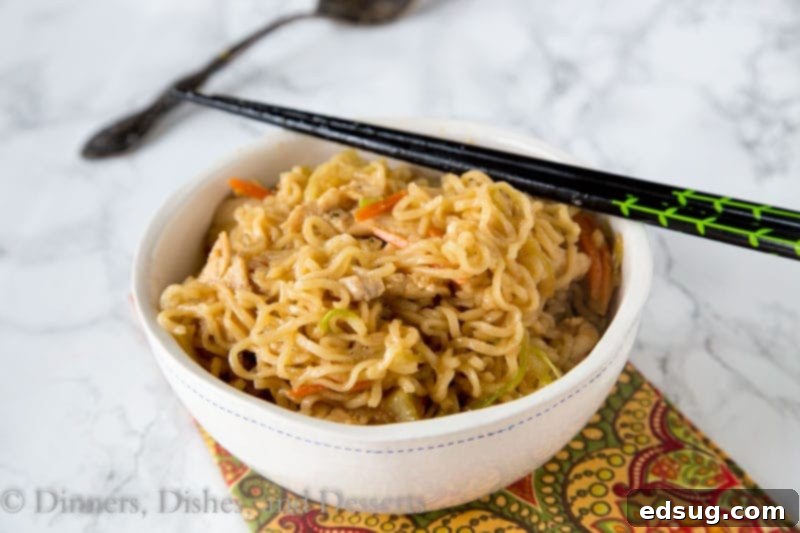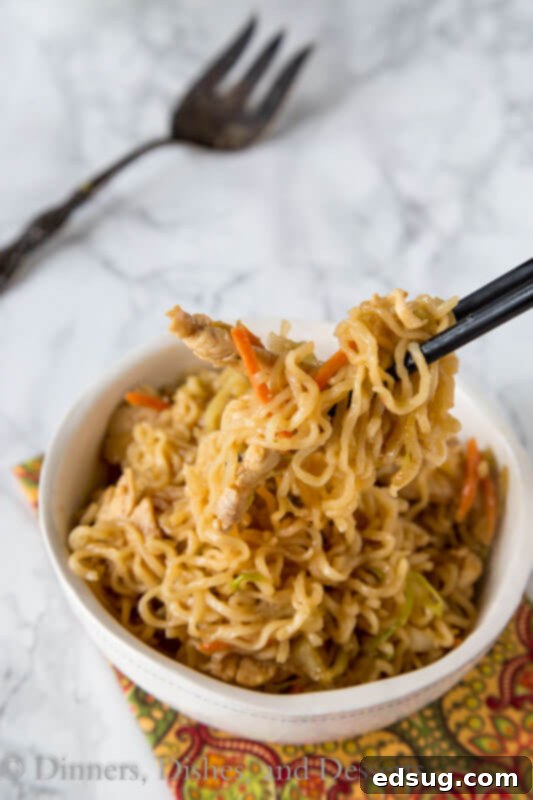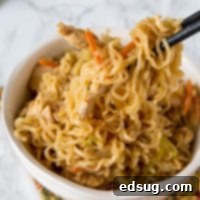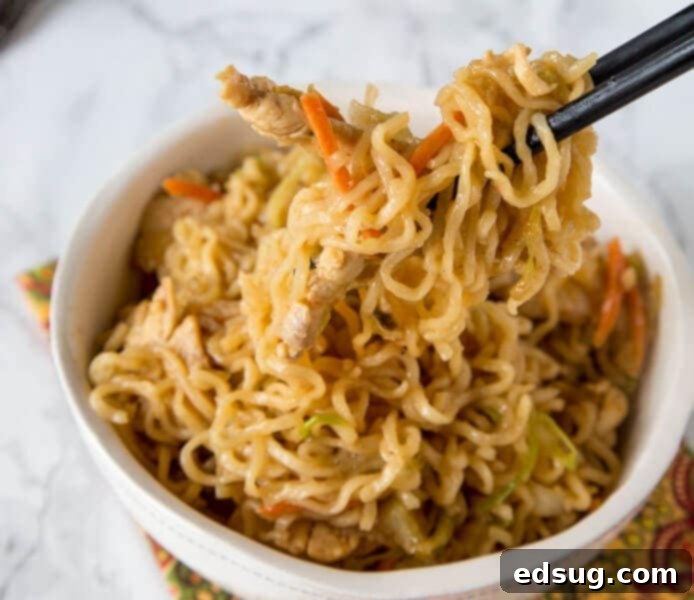Quick & Easy Homemade Chicken Chow Mein: Better Than Takeout in 20 Minutes!
Do weeknight dinners often mean reaching for the takeout menu? You’re not alone! In today’s busy world, it’s incredibly easy to fall into the habit of ordering in, especially when craving delicious Asian cuisine like Chinese food. While there’s certainly no shame in enjoying a convenient meal, many of us yearn for healthier, more customizable options that don’t sacrifice flavor or require a significant time commitment. This is where the magic of homemade Chicken Chow Mein comes in.
Imagine recreating your favorite Chinese restaurant classic right in your own kitchen, with fresh ingredients, in less time than it takes for delivery or pickup. This recipe for Chicken Chow Mein with Noodles offers just that – a simple, incredibly flavorful dish that comes together in mere minutes. Not only is it significantly healthier because you control every ingredient, but you can also tailor it precisely to your family’s tastes, loading it up with extra vegetables and lean protein. It’s the ultimate solution for a fast, satisfying, and wholesome meal.

My own love for chow mein started young. I remember my mom often opting for chow mein noodles whenever we got Chinese food, especially when my dad, a rather picky eater, stuck to his favorite Cashew Chicken. But the real chow mein revelation came during our mall trips, where my mom and I would always grab Panda Express chow mein. That vibrant, savory flavor stuck with me, inspiring me to recreate that beloved dish at home. Our family adores easy noodle dishes with authentic Asian flavors, so I knew a homemade version would be an instant hit – and it was!
This recipe brings that cherished takeout experience to your dinner table, packed with robust flavors and fresh ingredients, all with incredible ease. Get ready to ditch the delivery app and embrace the joy of a homemade meal that’s quicker, healthier, and just as delicious as your favorite restaurant’s offering.
Essential Ingredients for Your Homemade Chicken Chow Mein
Be sure to scroll to the bottom of the post for the FULL PRINTABLE recipe card with exact measurements.
Crafting delicious homemade chicken chow mein doesn’t require a trip to a specialty store. Many of these ingredients are likely already in your pantry or easily found at any grocery store. Here’s what you’ll need to create this fantastic dish:
- Ramen Noodle Packets: For this recipe, we utilize the convenience and affordability of dried ramen noodles, discarding the seasoning packet. This makes them a perfect base for our stir-fry. While ramen is a great shortcut, feel free to use any type of noodle you prefer! Fresh chow mein noodles, lo mein noodles, spaghetti, linguine, or even rice noodles would work beautifully. Just cook them according to package directions until al dente.
- Chicken Breast: Lean and tender, thinly sliced chicken breast cooks quickly and absorbs the sauce’s flavors wonderfully. You can also opt for boneless, skinless chicken thighs for a slightly richer flavor and more tender texture. Ensure the chicken is sliced uniformly for even cooking.
- Salt & Pepper: Simple seasonings to enhance the natural flavor of the chicken before it hits the pan.
- Olive Oil: Used for sautéing the chicken and vegetables. You can substitute with other high-smoke-point oils like canola, vegetable, or avocado oil.
- Onion: A small diced onion forms a fragrant aromatic base, adding a subtle sweetness and depth to the stir-fry.
- Shredded Cabbage: Cabbage is a classic chow mein ingredient, providing a satisfying crunch and volume. A pre-packaged coleslaw mix, which often includes shredded carrots, is a convenient alternative and adds extra color and nutrients.
- Garlic: Freshly minced garlic is essential for that unmistakable savory, pungent kick that defines Asian stir-fries.
- Ginger: Grated fresh ginger brings a warm, spicy, and aromatic note that complements the other flavors perfectly. Don’t underestimate the power of fresh ginger!
- Soy Sauce: The cornerstone of our savory sauce, providing umami depth. Low-sodium soy sauce can be used to control salt levels.
- Sesame Oil: A finishing oil that adds a distinct nutty aroma and rich flavor, crucial for an authentic Asian taste. Add it towards the end to preserve its delicate flavor.
With these fresh, simple ingredients, you’ll be well on your way to a truly exceptional homemade chow mein experience!

Step-by-Step Guide to Crafting Perfect Chicken Chow Mein
Making delicious chicken chow mein at home is surprisingly simple and incredibly fast. Follow these easy steps to get a flavorful meal on your table in no time:
- Prepare the Noodles: Start by bringing a large pot of water to a rolling boil. Add your chosen noodles – whether it’s dried ramen (remember to discard the seasoning packet), spaghetti, fresh chow mein noodles, or rice noodles – and cook them according to the package instructions until they are just al dente. You want them cooked but still with a slight bite, as they will continue to cook briefly in the stir-fry. Drain them well and set aside. Some prefer to rinse briefly to prevent sticking, but it’s optional.
- Brown the Chicken: Heat a large skillet, wok, or high-sided pan over medium-high heat. Add the olive oil and swirl to coat the bottom of the pan. Season your thinly sliced chicken breast with salt and pepper. Add the chicken to the hot pan in a single layer (cook in batches if necessary to avoid overcrowding, which steams rather than browns the chicken). Cook for 2-4 minutes until nicely browned and mostly cooked through. Thin slices are key here for quick and even cooking.
- Add the Veggies: Once the chicken is browned, add the diced onion and shredded cabbage (or coleslaw mix) to the skillet. Stir-fry for 3-5 minutes, or until the vegetables begin to soften but still retain a pleasant crisp-tender texture. Avoid overcooking, as we want them to remain vibrant and slightly crunchy.
- Whisk and Add the Sauce: In a small bowl, whisk together the minced garlic, grated fresh ginger, soy sauce, and sesame oil until well combined. Pour this flavorful sauce mixture directly over the chicken and vegetables in the skillet. Stir everything together, ensuring all ingredients are well coated with the savory sauce. Allow it to cook for another 3-5 minutes, letting the sauce slightly thicken and infuse into the chicken and vegetables.
- Toss with Noodles: Finally, add your cooked and drained noodles to the skillet. Using tongs, gently toss everything together until the noodles are thoroughly mixed with the chicken, vegetables, and sauce. Continue to stir-fry for 1-2 minutes, allowing the noodles to absorb the flavors and heat through.
- Serve and Garnish: Your homemade Chicken Chow Mein is ready to be devoured! Serve immediately while hot. For an extra touch of flavor and texture, you can get creative with garnishes. Consider topping with chopped green onions, toasted sesame seeds, a sprinkle of crunchy chopped peanuts, fresh cilantro, or a drizzle of sriracha for a little heat. Enjoy your delicious, quick, and satisfying meal!

Chow Mein vs. Lo Mein: Understanding the Key Distinction
It’s a common question when discussing popular Chinese noodle dishes: what’s the real difference between chow mein and lo mein? While both are delicious stir-fried noodle dishes, the primary distinction lies in how the noodles are prepared and incorporated into the dish.
Chow Mein literally translates to “stir-fried noodles.” The characteristic of chow mein is that the noodles are often cooked and then stir-fried until they achieve a slightly drier, sometimes crispier texture. There are generally two main styles of chow mein:
- Crispy Chow Mein (Hong Kong-style): In this version, the noodles are typically boiled until tender, then pressed into a cake and pan-fried until golden and crispy. The sauce, meat, and vegetables are then spooned over the crispy noodles.
- Steamed/Soft Chow Mein (American Chinese-style): This style, which our recipe leans towards, involves boiling the noodles until al dente, then adding them directly to the wok or skillet with the meat, vegetables, and sauce, and stir-frying them together. While not as crunchy as the crispy style, the noodles still undergo a stir-frying process, resulting in a distinct texture compared to lo mein.
Lo Mein, on the other hand, translates to “tossed noodles.” In lo mein, the noodles are boiled until fully cooked and tender. They are then added to a sauce, meat, and vegetable mixture and simply “tossed” or “stirred” to coat everything. The noodles in lo mein remain soft and pliable, acting as a vehicle for the sauce rather than becoming stir-fried themselves. Lo mein noodles are often thicker than those used for chow mein.
So, the core difference boils down to the final cooking step for the noodles: chow mein noodles are typically stir-fried, often to develop a firmer or crispier texture, while lo mein noodles are tossed and remain soft.
Customize Your Chow Mein: Tasty Additions & Variations
One of the best things about making homemade chow mein is the freedom to customize it with your favorite ingredients. This recipe is incredibly versatile, allowing you to experiment with different proteins, vegetables, and even sauce enhancements to suit your taste. Don’t be afraid to make it your own! Here are a few tasty ideas for what you can add to your chicken chow mein:
- Other Proteins:
- Pork: Thinly sliced pork loin or tenderloin works beautifully. You could even use ground pork for a different texture.
- Tofu: For a vegetarian option, press extra-firm tofu to remove excess water, then cube and pan-fry until golden brown before adding to the stir-fry.
- Shrimp: Quick-cooking shrimp adds a delightful seafood twist. Add them towards the end of cooking as they cook very quickly.
- Beef: Thinly sliced flank steak or sirloin, marinated briefly in a little soy sauce and cornstarch, makes for a hearty chow mein.
- More Vegetables for Color & Nutrients:
- Broccoli: Small florets add a lovely texture and vibrant green color. Steam or blanch them briefly before adding to the stir-fry.
- Snap Peas: Offer a sweet crunch. Add them in the last few minutes of cooking.
- Bell Peppers: Sliced red, yellow, or orange bell peppers bring sweetness and bright color.
- Bean Sprouts: A classic chow mein addition for extra crunch. Add them right at the very end and toss quickly.
- Mushrooms: Sliced shiitake, cremini, or button mushrooms add an earthy umami flavor.
- Carrots: Julienne-cut carrots provide sweetness and a pleasant crispness.
- Bok Choy: Roughly chopped bok choy wilts beautifully in the stir-fry, offering a mild, slightly bitter note.
- Water Chestnuts or Bamboo Shoots: For an authentic Asian texture and subtle flavor.
- Sauce Enhancements:
- Oyster Sauce: A tablespoon or two can add extra richness and umami.
- Hoisin Sauce: For a touch of sweet and tangy depth.
- Rice Vinegar: A splash can brighten the flavors.
- Brown Sugar or Honey: A teaspoon can balance the savory notes, especially if you add extra veggies.
- Chili Garlic Sauce or Sriracha: For those who enjoy a little heat.
- Garnishes:
- Green Onions: Sliced green onions are a traditional and fresh garnish.
- Sesame Seeds: Toasted sesame seeds add a nutty flavor and visual appeal.
- Chopped Peanuts or Cashews: For an extra layer of crunch and flavor.
With these endless possibilities, you can truly make this chow mein recipe your signature dish. Dinner on the table in 20 minutes can pretty much never be wrong, especially when it’s this delicious and versatile! And don’t forget the leftovers – my husband loves them for lunch, and reheating is completely optional. You know you enjoy eating cold leftover Chinese food right out of the box, so why not these?
Tips for Perfect Homemade Chow Mein
Achieving restaurant-quality chow mein at home is easier than you think, especially with a few key tips in mind:
- Mise en Place (Prep Everything First): Stir-frying is a fast cooking method, so having all your ingredients chopped, measured, and ready to go before you start cooking is crucial. This prevents burning and ensures a smooth cooking process.
- High Heat is Your Friend: Use a large skillet or, ideally, a wok over medium-high to high heat. High heat is essential for achieving that characteristic “wok hei” (breath of the wok) flavor and for cooking ingredients quickly without making them soggy.
- Don’t Overcrowd the Pan: Cook chicken and larger batches of vegetables in separate batches if your pan isn’t large enough. Overcrowding lowers the pan’s temperature, leading to steamed ingredients rather than properly stir-fried ones.
- Cook Noodles Al Dente: Since the noodles will continue to cook in the stir-fry, slightly undercooking them initially ensures they don’t become mushy.
- Thinly Slice Protein and Uniformly Chop Veggies: This promotes even cooking and ensures everything cooks quickly and simultaneously.
- Taste and Adjust Seasoning: Before serving, always taste your chow mein. You might want to add a little more soy sauce, a dash of sesame oil, or a pinch of sugar to balance the flavors to your liking.
Serving Suggestions for Your Asian Feast
While Chicken Chow Mein is a complete meal on its own, you can elevate your homemade Asian dinner experience by pairing it with a few complementary dishes:
- Appetizers: Start with classic favorites like crispy egg rolls, savory potstickers, or light spring rolls.
- Side Dishes: A simple bowl of steamed white or brown rice can be a nice accompaniment, especially if you have extra sauce. A quick cucumber salad or blanched broccoli with a drizzle of sesame oil also pairs well.
- Other Asian Dishes: If you’re hosting a feast, consider serving your chow mein alongside other easy Asian recipes like Coconut Chicken Curry or General Tso’s Chicken.
More Delicious Asian Dinner Recipes to Try
- Chicken Lo Mein
- Chicken Satay Stirfry
- Coconut Chicken Curry
- General Tso’s Chicken
- Mongolian Beef

Chicken Chow Mein: Your Favorite Takeout, Made at Home
Video
Ingredients
- 5 packets of Ramen noodles, seasoning packet discarded, or other desired stir-fry noodles
- 1 pound chicken breast, thinly sliced (thighs can be substituted)
- Salt and pepper, to taste
- 3 Tablespoon olive oil, or other high-smoke-point oil
- 1 small onion, diced
- 1 10 oz package shredded cabbage, or coleslaw mix with carrots
- 2 cloves garlic, minced
- 2 teaspoon fresh ginger, grated
- 1/3 cup soy sauce, low-sodium option available
- 3 teaspoon sesame oil, for authentic flavor
Instructions
- Bring a large pot of water to a rolling boil. Add the ramen noodles (discarding seasoning packets) or your preferred stir-fry noodles, and cook according to package directions until al dente. Drain well and set aside.5 packets of Ramen noodles
- Heat a large skillet or wok over medium-high heat. Add the olive oil, swirling to coat the bottom of the pan.3 Tablespoon olive oil
- Season the thinly sliced chicken with salt and pepper. Add it to the hot pan and cook for 2-4 minutes until browned and mostly cooked through. Stir in the diced onion and shredded cabbage; cook for an additional 3-5 minutes, until vegetables are tender-crisp.1 pound chicken breast, Salt and pepper, 1 small onion, 1 10 oz package shredded cabbage
- In a small bowl, whisk together the minced garlic, grated fresh ginger, soy sauce, and sesame oil. Pour this sauce mixture into the skillet with the chicken and vegetables. Stir to combine thoroughly and cook for 3-5 minutes, allowing the sauce to coat all ingredients and slightly thicken.2 cloves garlic, 2 teaspoon fresh ginger, 1/3 cup soy sauce, 3 teaspoon sesame oil
- Add the cooked noodles to the skillet. Using tongs, toss everything together vigorously until the noodles are fully coated with the sauce and well combined with the chicken and vegetables. Cook for another 1-2 minutes to heat through. Serve immediately, garnished with green onions or sesame seeds if desired.
Nutrition
Nutrition information is automatically calculated, so should only be used as an approximation.
Additional Info
I created a fun group on Facebook, and I would love for you to join us! It’s a place where you can share YOUR favorite recipes, ask questions, and see what’s new at Dinners, Dishes and Desserts (so that you never miss a new recipe)!
Be sure to follow me on Instagram and tag #dinnersdishes so I can see all the wonderful DINNERS, DISHES, AND DESSERTS recipes YOU make!
Don’t want to miss a single post? Be sure to follow me on my social media channels!
Facebook | Twitter | Pinterest | Instagram
.
